On November 19, 2019, an unlicensed and uninsured driver failed to slow down at the intersection of 69th Street and Stony Island Avenue in Chicago, hitting and killing a bicyclist.
On January 23, 2020, four people were killed in a crash involving a school bus, taxi, and a pickup truck at the intersection of Stony Island Avenue, 79th Street, and South Chicago Avenue. The pickup driver ran a red light, first hit the taxi driver and then the bus driver, who was at the intersection.
From 2019 to 2020, Chicago’s traffic fatalities increased by 16 percent – making 2020 the deadliest year for Illinois drivers in 13 years.
Given this sharp increase in deaths, are there areas of the city where motorists and other road users at an increased risk of injury or death?
We worked with data visualization firm 1Point21 Interactive to analyze Chicago crash data from 2018-2020 and find answers.
During the study period, there were a total of 328,799 traffic crashes in Chicago, resulting in 64,754 injuries, and 382 deaths.
While intersection-related crashes make up only 23 percent of total collisions, they result in a disproportionately high share of injuries and deaths. In fact, 44 percent of injuries and 33 percent of traffic deaths occurred at an intersection, making intersections among the most dangerous areas in Chicago for motorists and other road users.
While it’s clear that intersections, in general, pose an elevated risk of injury or death, which ones are the most dangerous? We created a collision risk index (CRI) that weighs collision volume along with injury severity to find out.
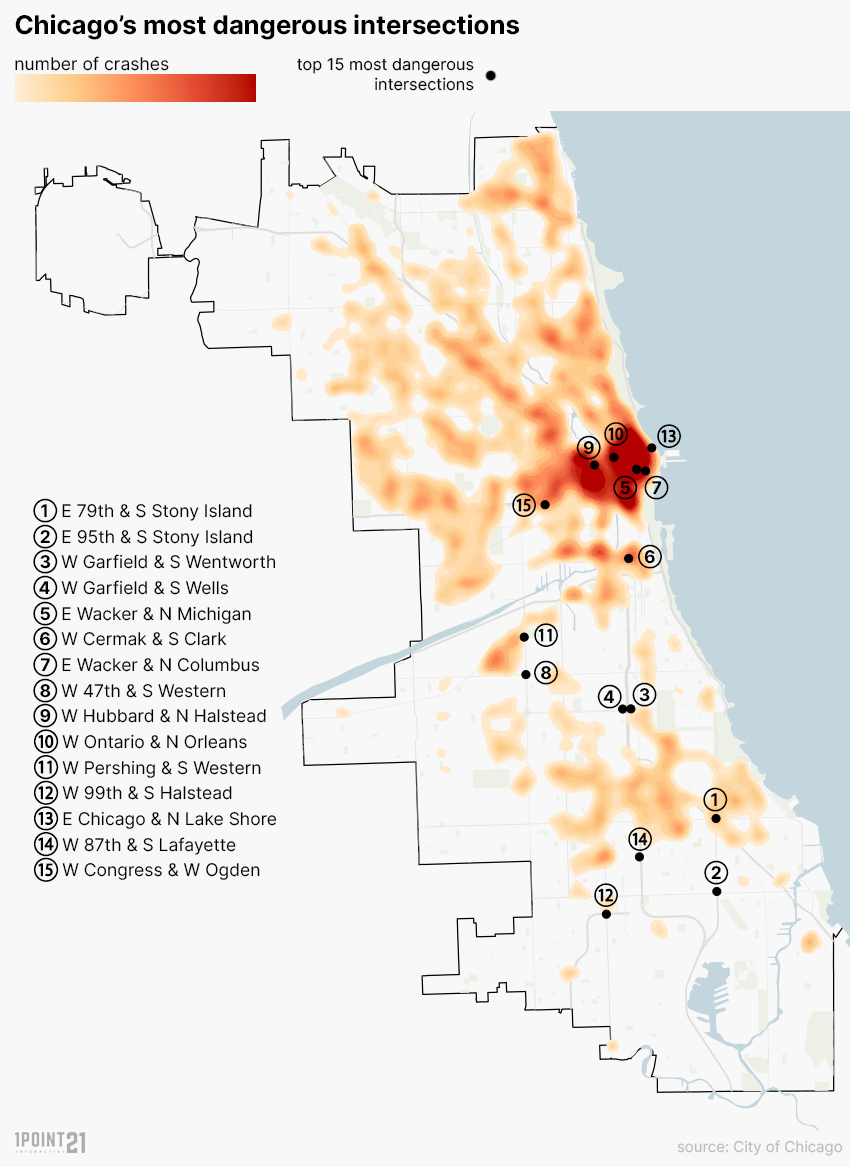
By this criteria, the most dangerous intersection in Chicago is at East 79th Street & South Stony Island Avenue, which had a CRI score of 293. From 2018-2020, this intersection saw more crashes and serious injuries than any other intersection in Chicago. There were 196 recorded crashes, one death, nine serious injuries, and 42 other injuries at this intersection.
This intersection has gained a reputation of being a “nightmare” and part of a “high crash corridor” for many road users. Busy doesn’t even begin to describe the intersection, which consists of overlapping traffic flows, limited space, and three bus routes. In the past, it has been named the most dangerous intersection due to its lack of protected bike lanes and complex structure that contribute to its safety risks for pedestrians, cyclists, and drivers.
The second most dangerous intersection in Chicago was East 9th Street & South Stony Island Avenue, which also had one fatality, 160 crashes, and a score of 229. Two of the top five intersections can be found right next to one another along West Garfield Boulevard. West Garfield Boulevard & South Wentworth Avenue – the third most dangerous intersection – and West Garfield and South Wells Street at number four.
The 15 most dangerous intersections in Chicago:
| Rank | Intersection | Crashes | Serious Injuries | Total Injuries | CRI |
|---|---|---|---|---|---|
| 1 | E 79th St & S Stony Island Ave | 196 | 9 | 52 | 293 |
| 2 | E 95th St & S Stony Island Ave | 160 | 4 | 44 | 229 |
| 3 | W Garfield Blvd & S Wentworth Ave | 141 | 6 | 55 | 220 |
| 4 | W Garfield Blvd & S Wells St | 131 | 4 | 42 | 189 |
| 5 | N Michigan Ave & E Wacker Dr | 125 | 3 | 26 | 163 |
| 6 | W Cermak Rd & S Clark St | 129 | 3 | 11 | 161 |
| 7 | N Columbus Dr & E Wacker Dr | 102 | 4 | 34 | 161 |
| 8 | W 47th St & S Western Blvd | 123 | 2 | 25 | 156 |
| 9 | N Halsted St & W Hubbard St | 121 | 1 | 25 | 150 |
| 10 | W Ontario St & N Orleans St | 132 | 1 | 12 | 148 |
| 11 | W Pershing Rd & S Western Ave | 113 | 2 | 25 | 146 |
| 12 | W 99th St & S Halsted St | 110 | 4 | 20 | 146 |
| 13 | E Chicago Ave & N Lake Shore Dr | 104 | 4 | 25 | 145 |
| 14 | W 87th St & S Lafayette Ave | 106 | 3 | 24 | 142 |
| 15 | W Congress Pkwy & W Ogden Ave | 98 | 4 | 24 | 138 |
After identifying problem intersections, we looked for other areas where increased collision risk may be present. Through our analysis, we determined the most “crash-prone” neighborhoods in Chicago by measuring the number of car crashes per mile per year. During 2018-2020, crashes were highly concentrated in the downtown area of Chicago.
Magnificent Mile was the most dangerous or “crash-prone” neighborhood with the most crashes per mile of road (156), followed by Grant Park (84), and Loop (62). Loop had fewer crashes than Grant Park and Magnificent Mile, but the most fatalities (11).
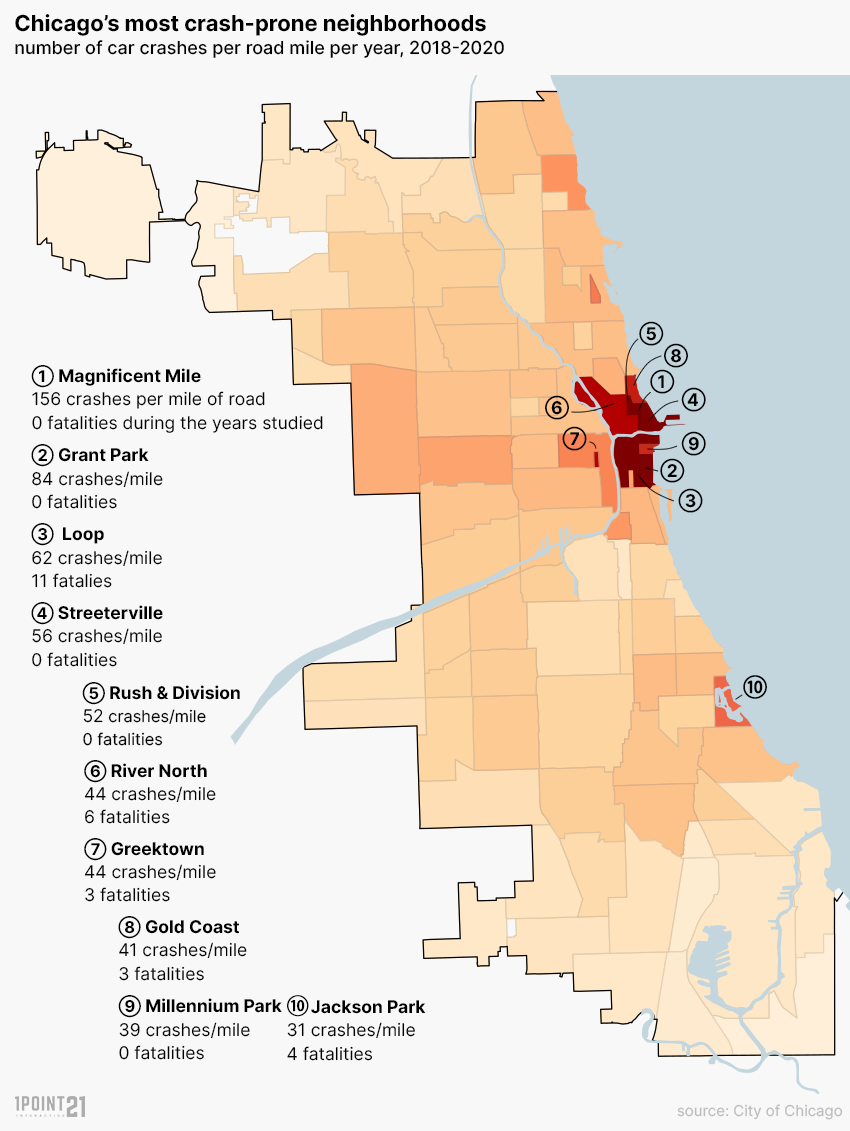
The 10 most crash-prone neighborhoods in Chicago:
In general, men are much more likely to be driving than women in Chicago car crashes – younger men in particular. In fact, male drivers aged 25-29 were involved in 93 percent more collisions than expected based on the number of registered drivers in that demographic. By this metric, older male and female drivers are – by far- the least likely be involved in a crash.
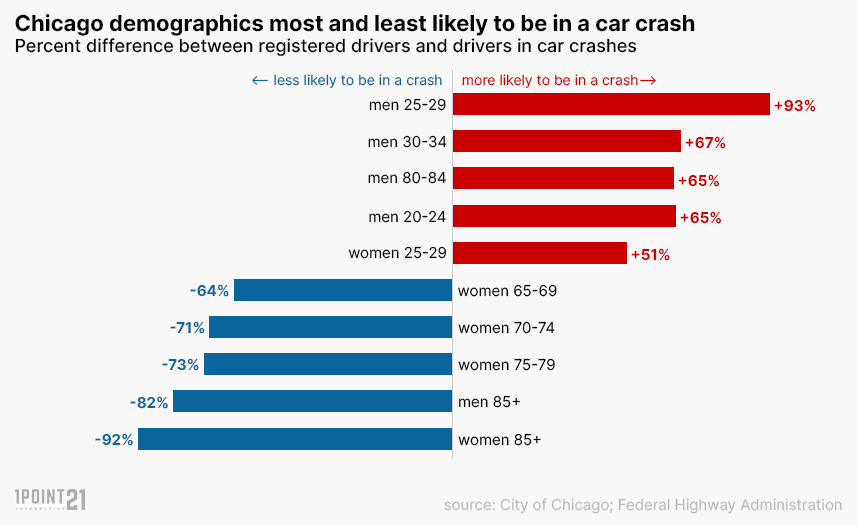
*Data for registered drivers was only available at the state level. We compared the demographics of registered drivers with the demographics of drivers involved in Chicago crashes from 2018-2020.
The three most common causes of motor vehicle collision were drivers failing to yield the right-of-way (22 percent), following too closely or tailgating (19 percent), and failing to reduce speed to avoid the crash (15 percent). In fact, more than half of all crashes were attributed to one of these three behaviors.
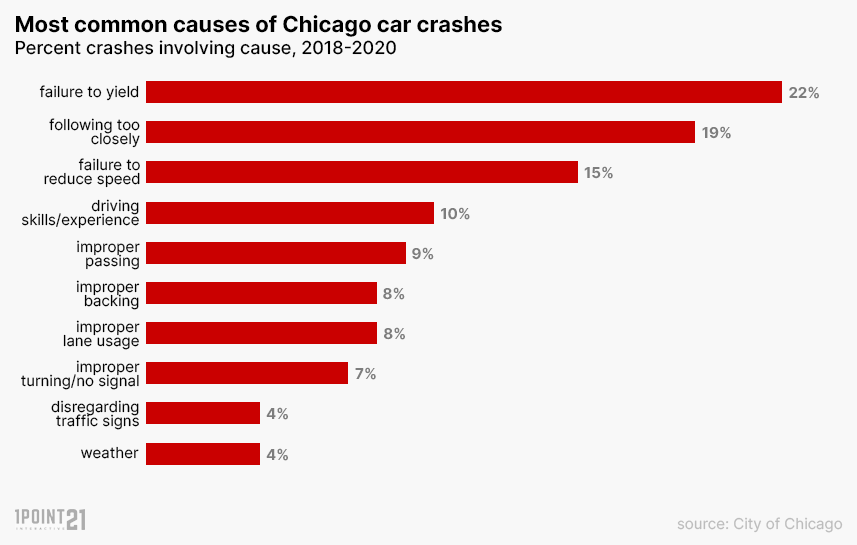
Inexperienced drivers (ten percent) and improper passing (nine percent) round out the top five. Interestingly, only four percent of crashes were attributed to disregard for traffic signals.
While failing to yield the right-of-way caused the most total crashes in Chicago (42,583), it was the second leading cause of traffic deaths (42). As you might expect, more people died when a driver failed to reduce speed (51) than any other factor.
However, the top crash factors are different in different areas of Chicago. We examined the most common crash factor by census tract. Failure to yield and following to closely are number one in most areas, but it was interesting to see that improper backing and inexperienced drivers were the top cause in several census tract areas.
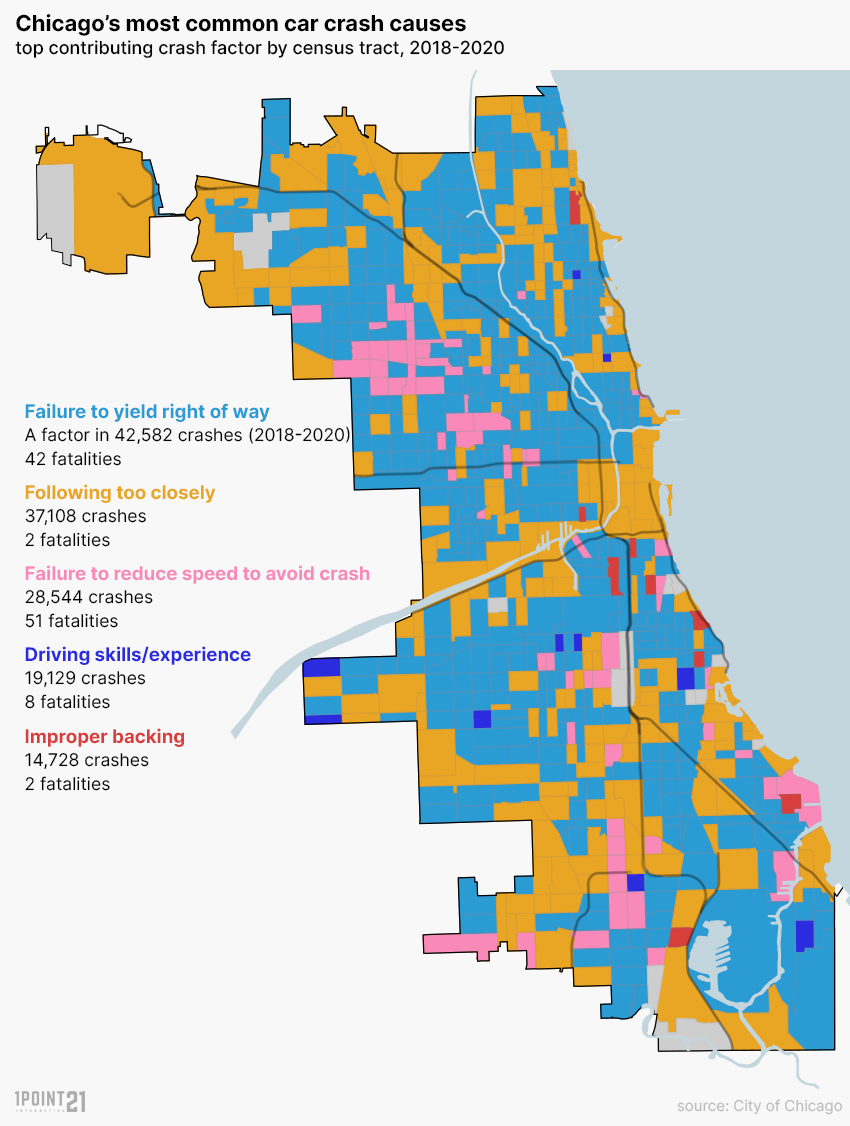
There are plans for redesigning the intersection at S 79th Street and S Stony Island, as well as hopes to receive federal funding to prioritize traffic safety for all road users. However, it is important for citizens to take safety into their own hands. Remember to take extra precautions while driving, riding, or walking on any roadway (but especially near well-known dangerous intersections of Chicago).
This study is based on crash data from the city of Chicago from 2018-2020 – the most complete and recent data available. Registered driver data was sourced from the Federal Highway Admin. and reflects data from 2019.
If you would like to report or republish our findings, please link to this page to provide a citation for our work.